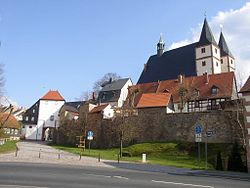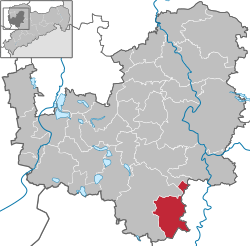Geithain
Geithain | |
|---|---|
 Saint Nicholas Church | |
 Coat of arms | |
show Location of Geithain within Leipzig district | |
 Geithain | |
| Coordinates: 51°3′N 12°41′E / 51.050°N 12.683°ECoordinates: 51°3′N 12°41′E / 51.050°N 12.683°E | |
| Country | Germany |
| State | Saxony |
| District | Leipzig |
| Subdivisions | 10 |
| Government | |
| • Mayor (2015–22) | Frank Rudolph[1] |
| Area | |
| • Total | 54.71 km2 (21.12 sq mi) |
| Elevation | 225 m (738 ft) |
| Population (2020-12-31)[2] | |
| • Total | 6,818 |
| • Density | 120/km2 (320/sq mi) |
| Time zone | UTC+01:00 (CET) |
| • Summer (DST) | UTC+02:00 (CEST) |
| Postal codes | 04643 |
| Dialling codes | 034341 |
| Vehicle registration | L, BNA, GHA, GRM, MTL, WUR |
| Website | www.geithain.de |
Geithain is a town in the Leipzig district, in the Free State of Saxony, Germany.
Geography[]
Geithain is 30 km (19 mi) northwest of Chemnitz and 40 km (25 mi) southeast of Leipzig. It lies in hilly country by the wooded area Wickershain and the river Eula.
History[]
The first documented mention of the town was in the year 1186 in a document, which described the donation of earnings from the Wickershainer Marion Church to the Bishop of Merseburg through the Duke .
The name of the town has its origins in the Old Sorbian word "Chytan" (Chyten) and describes the place of Chyten, where "Chyt" (Chit) is a Sorbian first name.
In 1209 there was another documented mention of Geithain and the already established Nicolai Church. In this year the establishment of a hospital and a chapel (of St. James) was ordered by Konrad II of Groitzsch (1190–1210), the Margrave of Lausitz. Also, although Geithain is described as a town in this document, a charter with the first mayor (Wiebke Drechsler) is first evident for the year 1335. From 1346 cisterns and wooden water conduits were constructed in Geithain, which were used until 1904.
Gaithain was administered in the Middle Ages by a Vogt, who had his seat in the Freihof, first mentioned in 1349. The Geithain powder-tower, today one of the sights of the town, was part of the Freihof and was inserted with this into the town's fortifications.
1936 was the 750th anniversary of Geithain. They had a celebration for 3 days around 1 September.
In World War II the town had 219 dead. On 13 April 1945 alone 13 people were killed in a single air raid on the town. The target of the low-flying aircraft was the railway station. On 14 April the Second World War ended for Geithain with the arrival of American troops.
As of 1 July 2017 Narsdorf has been incorporated into Geithain together with its parts Bruchheim, Dölitzsch, Kolka, Narsdorf, Niederpickenhain, Oberpickenhain, Ossa, Rathendorf, and Wenigossa[3]
Transport[]
Geithain is located on Neukieritzsch–Chemnitz and Leipzig–Geithain railway lines, which connect at Geithain station.
In 2013 another section of federal motorway A 72 was opened, also connecting Geithain with exit no 23 and via B 7.
Sons and daughters of the city[]
- Paul Guenther, (1860-1932), German-born American industrialist, emigrated to the US in 1890, in 1910 he was the largest stocking producer in the US
- Henning Frenzel, (born 1942), former football national player in the GDR
- Benjamin Hedericus (1675-1748), lexicographer
- Walter Risse, (1892-1965), officer, most recently general lieutenant in the Second World War
References[]
- ^ Bürgermeisterwahlen 2015, Freistaat Sachsen, accessed 12 July 2021.
- ^ "Bevölkerung des Freistaates Sachsen nach Gemeinden am 31. Dezember 2020". Statistisches Landesamt des Freistaates Sachsen (in German). June 2021.
- ^ "Eingemeindung Narsdorf". Stadt Geithein. Retrieved 24 July 2017.
- Towns in Saxony
- Geithain
- Leipzig (district)
- Kingdom of Saxony
- Bezirk Leipzig
- Saxony geography stubs


